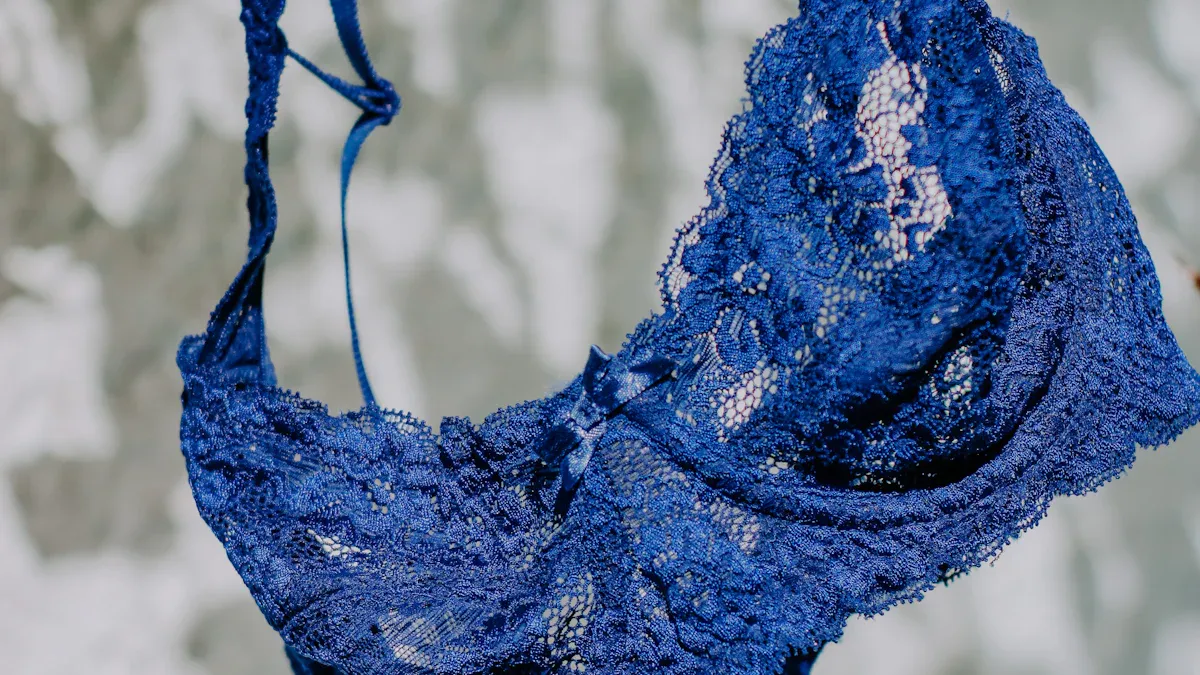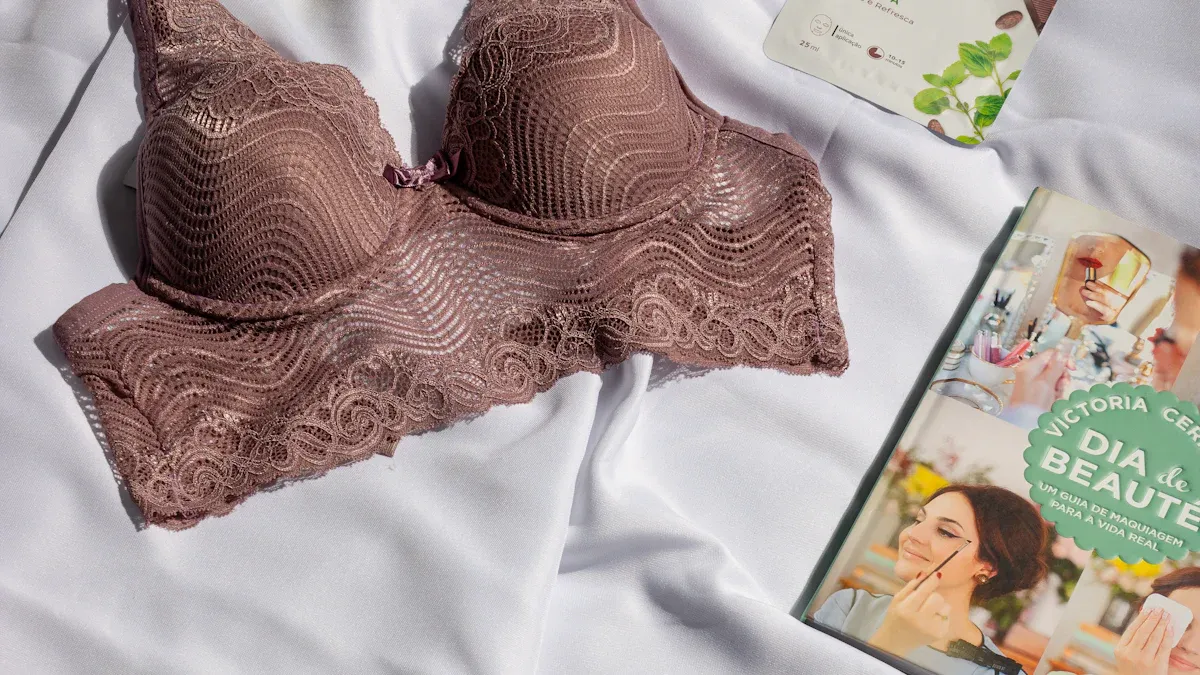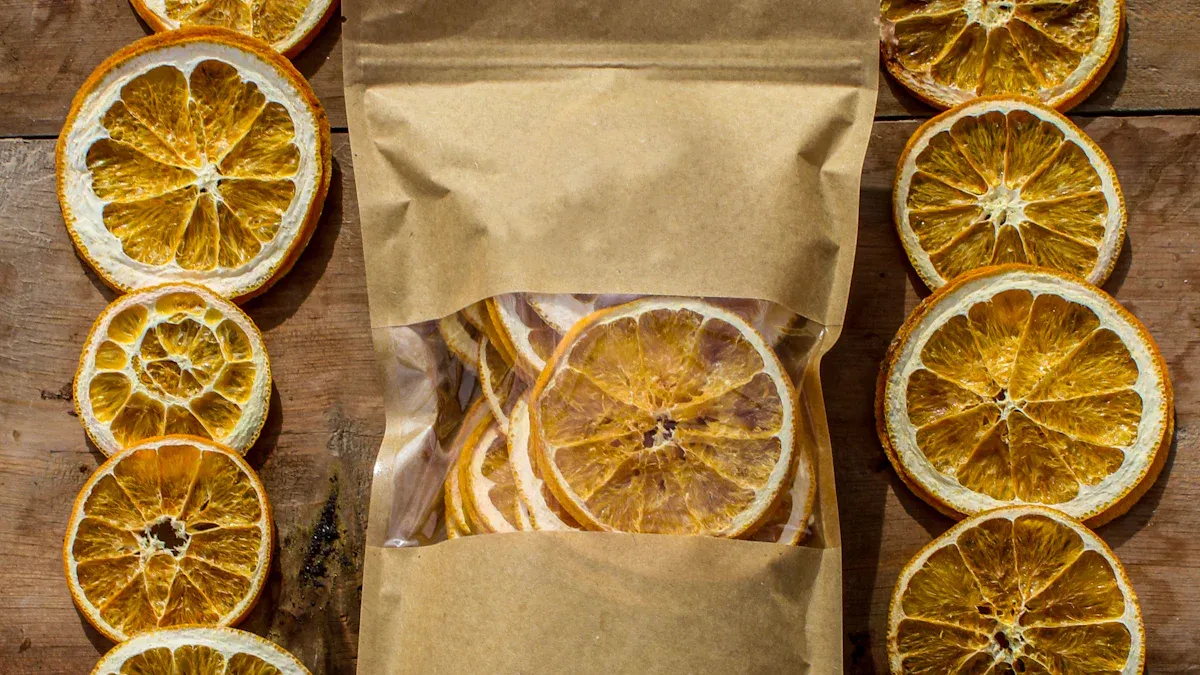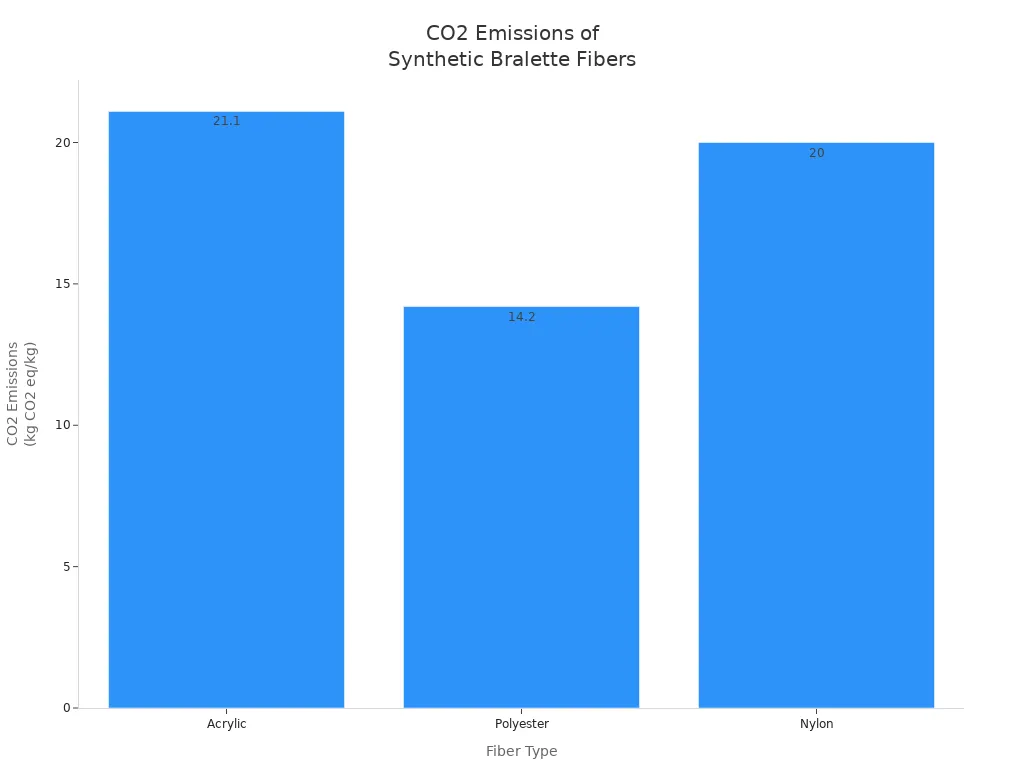
Choosing the right knit bralette fabrics changes how your bra feels and lasts. It also affects how well it supports you. Many people want soft and breathable fabrics. These fabrics help you stay comfortable all day. More brands now use eco-friendly materials like organic cotton and recycled fibers. This makes each bralette stylish and good for the planet.
Seamless knitting and moisture-wicking fabrics make bras more comfy and fit better.
Sustainable choices like bamboo and recycled materials set new rules for knit bralette fabrics.
People want to know how their bras are made and want them made fairly in 2025.
Key Takeaways
Pick soft and airy fabrics like organic cotton, bamboo, and wool. These feel good on your skin and are comfy all day.
Try to find eco-friendly materials like recycled fibers, modal, and TENCEL™. These help the Earth and make less trash.
Look for labels like GOTS, OEKO-TEX, and Fair Trade. These show your bralette is good for the planet and made the right way.
Choose seamless and stretchy knit bralettes. They fit better, give more support, and make less waste.
Pick a fabric that matches your style, comfort, and money plan. This way, you get both fashion and care for the Earth.
Why Fabric Choice Matters
Comfort and Fit
The fabric you pick for a bra really matters. It changes how the bra feels on your skin. A soft, non-toxic bra is comfy for daily use. Many knit bralettes use natural fibers like organic cotton or bamboo. These materials are gentle and soft. They work well for people with sensitive skin. Modern bralettes have special knit areas and stretchy fabrics. These designs give support without using wires. The bra feels like a second skin and moves with your body.
Here is a table that shows how different fabric features affect comfort and fit in bras:
Fabric Property | Impact on Bra Comfort and Fit |
|---|---|
Helps the bra keep its shape and move with you | |
Softness | Makes the bra feel nice for daily wear |
Water Absorption | Keeps you dry and comfortable |
Air Permeability | Lets air flow so the bra breathes |
Thermal Resistance | Keeps you cool or warm as needed |
Breathability and Durability
A bra that lets air flow and is non-toxic keeps you cool and fresh. Natural fabrics like hemp and modal let air pass through. This stops sweat from building up. Soft, non-toxic fabrics last longer if you take care of them. Studies show that how a fabric is knitted, like Milano rib or plain knit, changes how much air gets through and how well the bra keeps its shape. This means your favorite bralette can stay comfy and supportive after many washes.
Tip: Pick a soft, non-toxic bra with a natural knit for the best breathability and long-lasting wear.
Sustainability and Trends
In 2025, more brands use non-toxic, natural, and recycled fabrics for bralettes. Many companies now care about safe production and fair sourcing. New fabrics, like recycled PET and algae-based textiles, are getting popular. People want non-toxic bras that look good and feel soft every day. Research shows people care more about non-toxic, green, and breathable bras than before. Millennials and Gen Z lead this change. They pick natural, non-toxic bras that fit their values and lifestyle.
Best Knit Bralette Fabrics 2025

Organic Cotton
You can find organic cotton bras in many collections for 2025. These bras feel soft and gentle on your skin. Organic cotton is a natural fiber and uses no toxic chemicals. This makes it safe for sensitive skin and the earth. Brands often mix organic cotton with spandex or Lycra. This gives the bra more stretch and a better fit. You can pick from many styles, from simple to fancy, in organic cotton.
Organic cotton lingerie is comfy and good for the planet. It soaks up sweat well but may dry slower than some fabrics. If you wash it with care, your bra stays soft and lasts longer. Organic cotton bras come in many sizes and shapes, so you can find one that fits you.
Here is a quick look at how organic cotton and regular cotton compare:
Aspect | Organic Cotton | Conventional Cotton |
|---|---|---|
Use of Chemicals | No synthetic pesticides or GMOs | Uses chemical pesticides and fertilizers |
Soil Fertility | Kept healthy by crop rotation and natural ways | Soil gets worse over time |
Water Consumption | Needs more water | |
Carbon Emissions | Makes up to 46% less CO₂ | Makes more emissions |
Biodiversity | Helps many plants and animals | Chemicals hurt plants and animals |
Yield | Makes more cotton per acre | |
Land and Water Use | May need more land and water per pound | Needs less land and water per pound |
Certification | GOTS, OEKO-TEX show it is made right | Usually does not have strict labels |
Note: Check for GOTS or OEKO-TEX labels to know your organic cotton bras are really eco-friendly.
Wool & Merino Wool
Wool and merino wool have special benefits for bralettes. Merino wool feels soft and smooth, so it does not itch. This fiber pulls sweat away and dries fast, so you stay dry. Wool bralettes help stop bad smells and keep your body at a good temperature. You can wear them in hot or cold weather.
People often ask if wool or cotton is better for bras. Cotton is soft and lets air in, but it holds sweat longer. Wool, especially merino, dries faster and does not smell, so it is good for busy days. Both are natural and green, but wool has more features for sports.
Merino wool bralettes are light and bend easily. They give gentle support for daily use or light exercise. Many brands use wool from farms that follow good rules like Responsible Wool Standard. This means your bra is good for you and the earth.
Cashmere & Alpaca
Cashmere and alpaca make knit bralettes feel fancy. Cashmere is very soft and smooth, almost like silk. Alpaca can be even softer than cashmere. Both fibers keep you warm but do not feel heavy. You can wear a cashmere bralette in winter or on cool nights for extra comfort.
Here is a table to compare cashmere and alpaca:
Attribute | Cashmere | Alpaca Wool |
|---|---|---|
Softness | Very soft, fine fibers, feels rich | Sometimes softer than cashmere, also lets skin breathe and wicks sweat |
Warmth | Light but keeps you warm | Warmer and stronger than sheep wool, keeps heat in well |
Eco-friendliness | Natural, breaks down, can be recycled, animals not hurt | Natural, breaks down, gentle on earth, made in a green way, fair to workers |
Cashmere bralettes in 2025 have smooth designs and gentle support. Alpaca bralettes are warmer and last longer. Both fibers are natural, break down in nature, and are gathered without hurting animals. Alpaca farms often let animals roam free, which helps nature.
Modal & TENCEL™
Modal and TENCEL™ are new choices for knit bralettes. These fibers come from beechwood trees, which grow back fast. Modal bras feel soft, smooth, and cool on your skin. TENCEL™ also pulls sweat away and lets air in, so it is great for daily use.
Brands use smart ways to make modal and TENCEL™. They use forests that are managed well and systems that save water and cut waste. Look for labels like Fair Trade, GOTS, GRS, and OEKO-TEX to know your bra is safe and green.
Tip: Modal and TENCEL™ bralettes are vegan and have no animal parts.
Bamboo Viscose
Bamboo viscose is a top choice for soft bamboo bras. Bamboo grows fast, needs little water, and does not need sprays. This makes it a green pick for your bra. Bamboo fabric feels soft and smooth, sometimes even softer than cotton.
You will stay cool and dry because bamboo viscose pulls sweat away and lets air in. It is also naturally fights germs and is good for sensitive skin. Many brands use closed-loop systems to make bamboo viscose, which helps the planet.
Fights germs and is hypoallergenic
Breaks down in nature and is green
Lasts long and keeps its shape after washing
Hemp
Hemp is special in knit bralettes because it is strong and green. Hemp bras last a long time because the fibers are tough. You can wear a hemp bra for years, and it will still feel good.
Hemp is a natural fiber that grows with little water and no sprays. It makes soil better and takes in more CO2 than many trees. Hemp fabric fights germs and blocks UV rays, so it is good for your skin. Some people notice a smell in pure hemp, so brands often mix it with cotton to make it softer.
Lasts long and is tough
Light and can be used in many ways
Fights germs and blocks UV rays
Good for the earth and takes in carbon
Often mixed with cotton for comfort
Recycled Fibers
Recycled fibers help make knit bralettes greener. Brands use old cotton, factory scraps, and worn clothes to make new bras. This cuts down on trash and saves water and energy. You help the planet when you pick a bra made from recycled fibers.
New recycling turns old fabric into soft and stylish bralettes. Many brands use special tech to make these fabrics better and easier to break down. You will see recycled fibers in many new lines, as more people want green and cool bras.
Cuts down on trash in landfills
Saves water and energy
Helps the circular economy
Soft and stylish choices
Meets the need for green products
Note: Pick brands that tell you where their recycled fibers come from and how they are made.
Sustainable Materials for Bralettes

Certifications and Transparency
You should check if your bralette uses safe materials. Look for trusted certifications on the label. These show the fabric is safe for you and the earth. Here are some important ones:
GOTS organic means cotton is grown without bad chemicals and workers are treated fairly.
OEKO-TEX checks for over 300 harmful things, so your bralette is safe to wear.
Fairtrade International and Fair Trade USA make sure workers get fair pay and work in safe places.
Global Recycled Standard and Organic Content Standard check if fabrics are really recycled or organic.
Forest Stewardship Council helps make sure wood for fibers like TENCEL comes from good sources.
Brands that care about being open will tell you where their factories are. They also share how they make their products. You might see a QR code or tracking number on the label. This lets you follow your bralette from start to finish. Companies that do not use toxic dyes or chemicals, like azo dyes and PFAS, help you pick safer underwear.
Tip: Always look for these certifications. This helps you avoid fake green claims and get safe, eco-friendly, and fair products.
Ethical Production
Making underwear the right way is very important. WRAP-compliance means factories follow rules for fair pay, safe hours, and fire safety. When you buy bras made this way, you help workers get fair pay and safe jobs. Brands like Bleuet and Lucky & Me use WRAP-audited factories to keep these promises.
Factories with good practices also use safe materials like GOTS organic cotton and OEKO-TEX fabrics. This saves water, cuts down on chemicals, and lowers pollution. Some brands even recycle old bras, so less trash goes to landfills. When you choose non-toxic, fair, and green materials, you help people and the planet.
Certification/Standard | What It Ensures |
|---|---|
WRAP | Fair pay, safe hours, fire safety |
GOTS | Organic, safe, fair work |
OEKO-TEX | Safe, checked for bad substances |
Fairtrade | Fair pay, safe jobs |
Global Recycled Standard | Real recycled content, safe making process |
Picking safe, fair, and ethical ways to make bras helps make fashion cleaner, safer, and better for everyone.
Synthetic and Seamless Options
Synthetic fibers are important in today’s knit bralettes. You find these materials in many different styles. They make bras stronger and stretchier. Synthetics also give designers more ways to create new looks. These fibers help your bra last longer. They also help it fit better, especially if you want a seamless style.
Nylon & Polyamide
Nylon and polyamide are both strong and light. These fibers help your bra keep its shape. They do not soak up much water and dry fast. This keeps you feeling dry and comfy. Nylon does not wear out quickly, even after many washes. Your bra can look new for a long time.
Fiber Type | Key Properties Relevant to Knit Bralettes | Role in Enhancing Durability and Stretch |
|---|---|---|
Nylon / Polyamide | Strong, durable, abrasion resistant, lightweight, moisture resistant, good elasticity | Provides strength, abrasion resistance, and longevity to knit bralettes, ensuring durability |
Elastane (Spandex/Lycra) | Exceptional stretch and recovery, maintains shape, comfortable, resists degradation | Enables significant stretch and shape retention, enhancing fit and comfort in knit bralettes |
Acrylic
Acrylic is another man-made fiber used in some bras. It feels soft and keeps colors bright. But making acrylic uses more energy and water than other synthetics. Washing acrylic bras can release tiny plastic pieces into the water.

Acrylic breaks down very slowly in nature. It can add to ocean pollution with microplastics. When picking a bra, think about how the fiber affects the earth.
Elastane / Spandex
Elastane, also called spandex or Lycra, makes bras stretchy. This fiber lets your bra move with you and snap back. Elastane helps your bra fit close and stay put all day. You get support and comfort without wires.
Aspect | Evidence Summary |
|---|---|
Fit Benefits | Elastane provides excellent elasticity, allowing garments to stretch and conform snugly to the body. |
Products with elastane often appear smaller initially but stretch to fit comfortably. | |
Helps maintain shape and prevents sliding, enhancing comfort in knit bralettes and other garments. | |
Drawbacks – Recyclability | Elastane is a fully synthetic material, which poses challenges for recycling compared to natural fibers. |
Drawbacks – Skin Sensitivity | Even small amounts of elastane can cause irritation for sensitive skin. |
Care Requirements | Requires delicate washing (mesh bag, cool water, gentle detergent) and air drying to preserve elasticity. |
More labor-intensive care compared to some other fabrics. |
Seamless Knit Lingerie
Seamless knit lingerie is made with special machines. These machines make bras in one piece. This means there are fewer seams and no tags. Your bra feels smooth and does not itch or rub.
Seamless bras use lace bands for support, not wires.
The design uses less fabric and makes less waste.
Built-in elastic and body-mapping help bras fit better.
Seamless technology makes bras faster and allows cool designs.
Seamless bras are better for the planet because they make less waste. They also last longer. You get comfort, style, and a great fit in one bra.
Trends in Sustainable Bras 2025
Sheer and Lightweight Fabrics
This year, more bras use sheer and light fabrics. Designers pick materials like chiffon for a soft look. These fabrics feel light and are good for layering. Many brands use them for style and comfort. They also help the planet. Sheer knits keep you cool and look modern. You can wear these bras under clothes or by themselves.
Brand | Material Used | Trendy Feature |
|---|---|---|
Organic bamboo | Lightweight, padded crop bra | |
The Very Good Bra | Organic cotton print | Sheer, inclusive sizing |
tentree | Recycled, circular | Comfy, sustainable focus |
Hybrid and Circular Materials
Hybrid and circular materials are changing bras. Brands mix organic cotton, hemp, and recycled stuff. This makes bras last longer and feel better. Some companies use zero-waste and circular ideas. They design bras that can be reused or recycled later. You might see new materials like Piñatex or mushroom leather. These fabrics are gentle on skin and good for the earth.
Hybrid bras work as loungewear or streetwear.
Circular designs cut waste and help nature.
Cinnamon Swan and Cosabella use lyocell and recycled polyester for comfort and strength.
You get more choices with convertible and layered sets. These bras fit many needs and help your eco-friendly life.
Low-Impact Dyeing
Low-impact dyeing is a big trend for 2025. Brands use dyes that need less water and fewer chemicals. This keeps colors bright and helps the earth. Some use plant dyes or closed-loop systems to stop pollution. Picking bras with low-impact dyes helps keep water clean and workers safe. Look for labels about eco-friendly dyeing. You help make fashion safer for all.
Tip: Pick bras with low-impact dyes to help the planet.
How to Choose Knit Bralette Fabrics
Personal Comfort Needs
Comfort is the most important thing when picking a bralette. You want a bra that feels soft and lets your skin breathe. Many people like natural fibers such as cotton. Cotton soaks up sweat and feels gentle. Wool and new fibers like Cocona® help with sweat, especially in sweaty spots like the center front. Some synthetic fibers, like Coolmax®, pull sweat away but may not feel as soft as natural ones.
Think about how the fabric stretches and moves with you. Bralettes with elastic knits and good yarns let you move easily. This is true if you are sitting, standing, or walking. Softness, strength, and breathability all help you feel good every day. If your skin is sensitive, pick non-toxic fabrics without harsh chemicals.
Pick natural fibers for softness and soaking up sweat.
Choose elastic knits for easy movement.
Use non-toxic fabrics if your skin is sensitive.
Sustainability Priorities
If you care about the earth, look for bralettes with trusted labels. These labels show your bra is made with care for people and nature.
GOTS means the fabric is organic and follows strict rules.
Fair Trade Certification shows workers get fair pay and safe jobs.
Bluesign means the fabric avoids bad chemicals.
Brands that share how and where they make bras care about the planet.
Eco-friendly materials like organic cotton and recycled fibers help nature. Non-toxic making keeps you and the earth safe. When you check for these labels, you make sure your bra fits your values.
Style and Budget
There is a bralette for every style and price. Most people pick nylon-spandex blends for support and a good price. If you want something special, modal or Tencel blends feel soft and look nice. Eco-friendly choices like recycled nylon or organic cotton cost more but are better for the earth.
Luxury buyers may pick lace or silk for a fancy look. Lace looks pretty but can make the price go up by 30-50%. Some brands use fancy fabrics only in places you can see to save money. If you want a bralette for all sizes, look for brands with many sizes and stretchy, supportive fabrics.
Consumer Type | Fabric Choice | Key Benefit |
|---|---|---|
Everyday | Nylon-spandex, cotton blends | Comfort, affordability |
Eco-conscious | Organic cotton, recycled fibers | Sustainability, non-toxic |
Luxury | Lace, silk, modal blends | Style, softness |
Tip: Pick a bralette fabric that fits your style, comfort, and budget for the best daily wear.
There are lots of good knit bralette fabrics to pick in 2025. Experts say these are best for comfort, the planet, and style:
Organic cotton feels soft and is better for nature
Bamboo and hemp let air in and keep things fresh
Recycled polyester is strong and helps cut down on trash
Modal, elastane, and lyocell stretch well and are eco-friendly
If you want to help fair brands, you can:
Pick brands that care about the earth
Make sure workers are treated well and safe
Choose companies that make less pollution and use vegan stuff
Try out new green fabrics and help make fashion kinder to everyone.
FAQ
What is the softest fabric for knit bralettes?
You will find that cashmere and modal feel the softest. Cashmere gives a luxury touch. Modal feels smooth and gentle on your skin. Both work well for daily comfort.
How do I know if a bralette fabric is sustainable?
Look for trusted labels like GOTS, OEKO-TEX, or Fair Trade. These show the fabric meets strict eco-friendly and ethical standards. You can also check the brand’s website for more details.
Can I wear a wool bralette in summer?
Yes, you can. Merino wool keeps you cool by letting air flow and pulling sweat away. You stay dry and comfortable, even on warm days.
How should I wash my knit bralette?
Tip: Always check the care label first.
Hand wash in cool water with gentle soap. Air dry flat to keep the shape. Avoid bleach and high heat.
Which fabric is best for sensitive skin?
Fabric | Skin Friendliness |
|---|---|
Organic Cotton | Excellent |
Bamboo | Excellent |
Modal | Very Good |
You should pick organic cotton or bamboo for the best comfort if you have sensitive skin.









